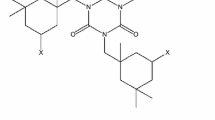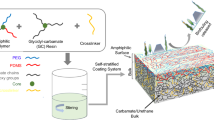Abstract
Siloxane–polyurethane paints were formulated and characterized for coating properties and performance as fouling-release (FR) marine coatings. Paints were formulated at 20 and 30 pigment volume concentrations with titanium dioxide, and aminopropyl-terminated poly(dimethylsiloxane) (APT-PDMS) loadings were varied from 0 to 30% based on binder mass. The coatings were characterized for water contact angle, surface energy (SE), gloss, and pseudobarnacle (PB) adhesion. The assessment of the FR performance compared with polyurethane (PU) and silicone standards through the use of laboratory biological assays was also performed. Biofilm retention and adhesion were conducted with the marine bacterium Cellulophaga lytica, and the microalgae diatom Navicula incerta. Live adult barnacle reattachment using Amphibalanus amphitrite was also performed. The pigmented coatings were found to have properties and FR performance similar to those prepared without pigment. However, a higher loading of PDMS was required, in some cases, to obtain the same properties as coatings prepared without pigment. These coatings rely on a self-stratification mechanism to bring the PDMS to the coating surface. The slight reduction in water contact angle (WCA) and increase in pseudobarnacle release force with pigmentation suggests that pigmentation slowed or interfered with the self-stratification mechanism. However, increasing the PDMS loading is an apparent method for overcoming this issue, allowing for coatings having similar properties as those of clear coatings and FR performance similar to those of silicone standard coatings.









Similar content being viewed by others
References
Yebra, DM, Kiil, S, Dam-Johansen, K, “Antifouling Technology—Past, Present and Future Steps Towards Efficient and Environmentally Friendly Antifouling Coatings.” Prog. Org. Coat., 50 75–104 (2004)
Stupak, ME, García, MT, Pérez, MC, “Non-Toxic Alternative Compounds for Marine Antifouling Paints.” Int. Biodeterior. Biodegrad., 52 49–52 (2003)
Champ, MA, “A Review of Organotin Regulatory Strategies, Pending Actions, Related Costs and Benefits.” Sci. Total Environ., 258 (1–2) 21–71 (2000)
Piola, RF, Dafforn, KA, Johnston, EL, “The Influence of Antifouling Practices on Marine Invasions.” Biofouling, 25 633–644 (2009)
Godwin, LS, “Hull Fouling of Maritime Vessels as a Pathway for Maritime Species Invasions to the Hawaiian Islands.” Biofouling, 19 (Supplement) 123–131 (2003)
Callow, ME, Callow, JA, “Marine Biofouling: A Sticky Problem.” Biologist, 49 (1) 10–14 (2002)
Anderson, C, Atlar, M, Callow, M, Candries, M, Milne, A, Townsin, RL, “The Development of Foul-Release Coatings for Seagoing Vessels.” J. Mar. Des. Oper., 84 11–23 (2003)
Brady, R, “Clean Hulls Without Poisons: Devising and Testing Nontoxic Marine Coatings.” J. Coat. Technol., 72 (900) 44–56 (2000)
Webster, D, Chisholm, B, New Directions in Antifouling Technology, pp. 366–387. Wiley–Blackwell, Singapore, 2010
Majumdar, P, Ekin A, Webster, DC, “Thermoset Siloxane–Urethane Fouling Release Coatings.” ACS Symposium Series 957 (Smart Coatings), pp. 61–75, 2007
Pieper, RJ, Ekin, A, Webster, DC, Cassé, F, Callow, JA, Callow, ME, “Combinatorial Approach to Study the Effect of Acrylic Polyol Composition on the Properties of Crosslinked Siloxane–Polyurethane Fouling-Release Coatings.” J. Coat. Technol. Res., 4 (4) 453–461 (2007)
Ekin, A, Webster, DC, “Combinatorial and High-Throughput Screening of the Effect of Siloxane Composition on the Surface Properties of Crosslinked Siloxane–Polyurethane Coatings.” J. Comb. Chem., 9 178–188 (2007)
Sommer, S, Ekin, A, Webster, D, Stafslien, S, Daniels, J, VanderWal, L, Thompson, S, Callow, M, Callow, J, “A Preliminary Study on the Properties and Fouling-Release Performance of Siloxane–Polyurethane Coatings Prepared from Poly(dimethylsiloxane) (PDMS) Macromers.” Biofouling, 26 (8) 961–972 (2010)
Fagelman, K, Guthrie, J, “Polymer Blend Formulation and Processing, with Reference to the Nature and the Behaviour of Pigmented Polycarbonate–Poly(butylene terephthalate) (PC–PBT) Blends.” Surf. Coat. Int. B: Coat. Trans., 89 (1) 1–14 (2006)
Stafslien, S, Daniels, J, Mayo, B, Christianson, D, Chisholm, B, Ekin, A, Webster, D, Swain, G, “Combinatorial Materials Research Applied to the Development of New Surface Coatings IV. A High Throughput Bacterial Biofilm Retention and Retraction Assay for Screening Fouling-Release Performance of Coatings.” Biofouling, 23 (1) 45–54 (2007)
Finlay, JA, Bennett, SM, Brewer, LH, Sokolova, A, Clay, G, Gunari, N, Meyer, AW, Walker, GC, Wendt, DE, Callow, ME, Callow, JA, Detty, MR, “Barnacle Settlement and Adhesion of Protein and Diatom Microfouling to Xerogel Films with Varying Wettability.” Biofouling, 26 657–666 (2010)
Holland, R, Dugdale, TM, Wetherbee, R, Brennan, AB, Finlay, JA, Callow, JA, Callow, ME, “Adhesion and Motility of Fouling Diatoms on a Silicone Elastomer.” Biofouling, 20 323–329 (2004)
Rittschof, D, Orihuela, B, Stafslien, S, Daniels, J, Christianson, D, Chisholm, B, Holm, E, “Barnacle Reattachment: A Tool for Studying Barnacle Adhesion.” Biofouling, 24 (1) 1–9 (2008)
Ekin, A, Webster, DC, Daniels, JW, Stafslien, SJ, Cassé, F, Callow, JA, Callow, ME, “Synthesis, Formulation and Characterization of Siloxane–Polyurethane Coatings for Underwater Marine Applications Using Combinatorial High-Throughput Experimentation.” J. Coat. Technol. Res., 4 (4) 435–451 (2007)
Patton, T, Paint Flow and Pigment Dispersion. John Wiley & Sons, New York, 1979
Owens, DK, Wendt, RC, “Estimation of the Surface Free Energy of Polymers.” J. Appl. Polym. Sci., 13 (8) 1741–1747 (1969)
Chisholm, BJ, Webster, DC, Bennett, JC, Berry, M, Christianson, D, Kim, J, Mayo, B, Gubbins, N, “Combinatorial Materials Research Applied to the Development of New Surface Coatings VII: An Automated System for Adhesion Testing.” Rev. Sci. Instrum., 78 (7) 072213 (2007)
Majumdar, P, Lee, E, Patel, N, Ward, K, Stafslien, SJ, Daniels, J, Chisholm, BJ, Boudjouk, P, Callow, ME, Callow, JA, Thompson, SEM, “Combinatorial Materials Research Applied to the Development of New Surface Coatings IX: An Investigation of Novel Antifouling/Fouling-Release Coatings Containing Quaternary Ammonium Salt Groups.” Biofouling, 24 (3) 185–200 (2008)
Kugel, AJ, Jarabek, LE, Daniels, JW, Wal, LJV, Ebert, SM, Jepperson, MJ, Stafslien, SJ, Pieper, RJ, Webster, DC, Bahr, J, Chisholm, BJ, “Combinatorial Materials Research Applied to the Development of New Surface Coatings XII: Novel, Environmentally Friendly Antimicrobial Coatings Derived from Biocide-Functional Acrylic Polyols and Isocyanates.” J. Coat. Technol. Res., 6 (1) 107–121 (2009)
Stafslien, SJ, Bahr, JA, Feser, JM, Weisz, JC, Chisholm, BJ, Ready, TE, Boudjouk, P, “Combinatorial Materials Research Applied to the Development of New Surface Coatings I: A Multiwell Plate Screening Method for the High-Throughput Assessment of Bacterial Biofilm Retention on Surfaces.” J. Comb. Chem., 8 (2) 156–162 (2006)
Stafslien, SJ, Bahr, JA, Daniels, JW, Vander Wal, L, Nevins, J, Smith, J, Schiele, K, Chisholm, B, “Combinatorial Materials Research Applied to the Development of New Surface Coatings VI: An Automated Spinning Water Jet Apparatus for the High-Throughput Characterization of Fouling-Release Marine Coatings.” Rev. Sci. Instrum., 78 (7) 072204–072206 (2007)
Cassé, F, Stafslien, SJ, Bahr, JA, Daniels, J, Finlay, JA, Callow, JA, Callow, ME, “Combinatorial Materials Research Applied to the Development of New Surface Coatings V. Application of a Spinning Water-Jet for the Semi-High Throughput Assessment of the Attachments Strength of Marine Fouling Algae.” Biofouling, 23 (2) 121–130 (2007)
Chen, Z, Chisholm, B, Kim, J, Stafslien, S, Wagner, R, Patel, S, Daniels, J, Wal, LV, Li, J, Ward, K, Callow, M, Thompson, S, Siripirom, C, “UV-Curable, Oxetane-Toughened Epoxy-Siloxane Coatings for Marine Fouling-Release Coating Applications.” Polym. Int., 57 (6) 879–886 (2008)
Kim, J, Nyren-Erickson, E, Stafslien, S, Daniels, J, Bahr, J, Chisholm, BJ, “Release Characteristics of Reattached Barnacles to Non-Toxic Silicone Coatings.” Biofouling, 24 (4) 313–319 (2008)
Majumdar, P, Stafslien, S, Daniels, J, Webster, DC, “High Throughput Combinatorial Characterization of Thermosetting Siloxane–Urethane Coatings Having Spontaneously Formed Microtopographical Surfaces.” J. Coat. Technol. Res., 4 (2) 131–138 (2007)
Schultz, MP, “Effects of Coating Roughness and Biofouling on Ship Resistance and Powering.” Biofouling, 23 (5) 331–341 (2007)
Acknowledgments
The authors gratefully acknowledge the Office of Naval Research for supporting this study, under the grant N00014-09-1-1193. The authors also thank Stanislas Ogokeh for assistance in conducting SE measurements and Dr. Dan Rittshof and Beatriz Orihuela of the Duke University Marine Laboratory for supplying live barnacles for testing.
Author information
Authors and Affiliations
Corresponding author
Additional information
This paper was awarded First Place in the John A. Gordon Best Paper competition at the 2011 CoatingsTech Conference, sponsored by ACA, March 14–16, 2011, in Rosemont, IL.
An erratum to this article can be found at http://dx.doi.org/10.1007/s11998-012-9400-3.
Rights and permissions
About this article
Cite this article
Sommer, S.A., Byrom, J.R., Fischer, H.D. et al. Effects of pigmentation on siloxane–polyurethane coatings and their performance as fouling-release marine coatings. J Coat Technol Res 8, 661–670 (2011). https://doi.org/10.1007/s11998-011-9340-3
Published:
Issue Date:
DOI: https://doi.org/10.1007/s11998-011-9340-3




